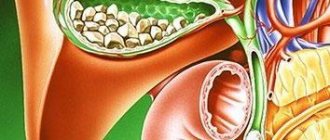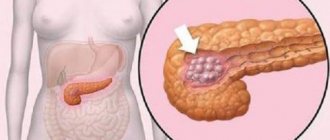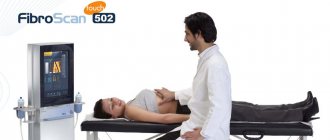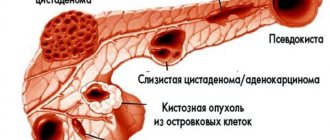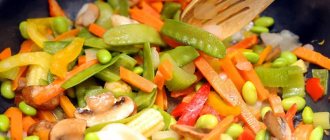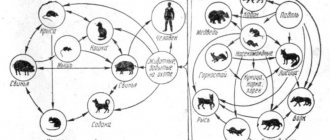Pancreatitis is an acute or chronic inflammation of the pancreas tissue with subsequent disruption of the secretory and endocrine functions of the organ. Most often, the development of pathology is associated with systematic consumption of large amounts of alcohol, smoking, and cholelithiasis.
During an exacerbation of pancreatitis, a person experiences prolonged intense pain in the upper half of the abdomen, his digestion process is disrupted, and yellowness of the skin and mucous membranes may appear.
Treatment includes following a diet, taking medications to facilitate the digestion of food, and painkillers. In some cases, surgery may be required.
According to statistics, in general, the prevalence of the disease does not depend on gender. However, acute alcoholic pancreatitis occurs more often in men, which is associated with a greater addiction to alcoholic beverages among this population group. The disease mainly affects people of working age from 30 to 50 years. In women, the development of pancreatitis is more often caused by gallstone disease.
Inflammation of the pancreas
Pancreatitis is inflammation of the pancreas and can be acute or chronic. Causes – poor diet, stones in the bile ducts, poisoning, smoking, chronic alcoholism, disruption of the gastrointestinal tract (stomach, duodenum), viral diseases, infections, etc. Symptoms of acute pancreatitis – nausea, vomiting, heartburn, aching, monotonous pain in abdomen, in the left hypochondrium, persisting for several days. As well as spasmodic pain in the lower abdomen, flatulence, abnormal bowel movements (diarrhea or constipation), chills or excessive sweating, an unpleasant taste in the mouth, and changes in skin color.
Reasons for the development of pancreatitis
The disease develops due to damage to pancreatic tissue. This happens for the following reasons:
- alcohol and tobacco abuse
- abdominal trauma, surgery
- uncontrolled and long-term use of medications: antibiotics, hormonal drugs, corticosteroids, some diuretics
- intoxication with food products, chemicals
- genetic predisposition
- improper diet with a predominance of spicy and fatty foods and long breaks between meals
Treatment of pancreatic inflammation
Treatment of acute pancreatitis should take place in a hospital.
First aid - you need to apply an ice bag to the left hypochondrium, avoid eating any food. Drug treatment includes taking antispasmodics, painkillers (opioid analgesics), and antiemetics. In the acute phase, infusion drugs are administered intravenously. For complications, antibiotics may be prescribed. Fasting is observed for three to five days or parenteral nutrition is used.
Therapy for the chronic form of the disease is based on quitting smoking, drinking alcohol, diet therapy with a small amount of fat in the diet, using painkillers, taking enzyme preparations; antidepressants (pregabalin, gabapentin) can be prescribed to relieve pain, as well as treatment of complications.
If there are stones in the gland ducts, then it is rational to perform lithotripsy and endoscopic therapy.
Surgical treatment is performed when drug therapy is impossible or the body is tolerant to their action.
The duration of treatment depends on the form and complications of the disease, and on the body’s susceptibility to therapy.
What else is important to know about enzyme preparations?
The minimum starting dosage is Creon® 25,000 units, which is stated in Russian recommendations for the treatment of chronic pancreatitis and exocrine pancreatic insufficiency2,5. The number indicates the amount of the enzyme lipase, which helps digest fats. If necessary, the doctor can increase the dosage; in European practice, the required dose per single dose can reach up to 80,000 units8. By comparison, the pancreas of a healthy person produces up to 720,000 of these units during each meal9.
Therapy should be taken seriously, since high-quality “nutrition” of the body is the key to its functioning. How long can a person live without energy from food? With chronic pancreatitis, the body must be supplied with enzymes at every meal, even with a snack. Thus, in accordance with the instructions for the drug Creon®, a full dose is required for a meal (for example, 25,000 units), and half for a snack. Creon® capsules are convenient to use: you can open them and add minimicrospheres to food, thereby selecting the desired dose10. More information about the admission rules can be found here.
Pancreatic tumors
A pancreatic tumor can be of two types – cancer and a hormonally active tumor.
Men are more often affected; the average age is 55 years. Most often the tumor is localized in the head of the gland. Factors that provoke the development of pancreatic cancer include smoking, chronic pancreatitis, high body mass index, and male gender.
Symptoms of cancer depend on the part of the gland that is affected. If the head of the gland is affected, jaundice may develop, because compression of the bile duct occurs. Skin itching appears. When the body and tail are affected, diabetes mellitus, varicose veins of the esophagus and stomach, and the risk of bleeding develop.
Treatment is surgical or chemotherapy.
Chronic pancreatitis: diagnosis and treatment
Chronic pancreatitis is a group of diseases (variants of chronic pancreatitis), which are characterized by various etiological factors, the presence of focal necrosis in the pancreas against the background of segmental fibrosis with the development of functional failure of varying severity [1]. The progression of chronic pancreatitis leads to the appearance and development of atrophy of glandular tissue, fibrosis and replacement of cellular elements of the pancreatic parenchyma with connective tissue. The literature of recent years contains publications that provide the opinions of some researchers about the stages of the course (progression) of chronic pancreatitis. According to one of them [6], the initial period of the disease, the stage of exocrine pancreatic insufficiency and the complicated version of the course of chronic pancreatitis are distinguished - tumors of this organ; however, apparently, other variants of the course of chronic pancreatitis are also possible.
Clinical manifestations of chronic pancreatitis
Analysis of medical documents of patients sent from outpatient clinics to a hospital for further examination and treatment with a preliminary diagnosis of “pancreatitis” (“exacerbation of chronic pancreatitis”), and medical records of patients who, as a result of the examination, were diagnosed with “exacerbation” as the main one chronic pancreatitis” showed that often both diagnoses are not true. It was found that in some cases there was no data indicating the presence of chronic pancreatitis at all, while in others it was a case of chronic pancreatitis in remission. As the examination showed, patients were forced to consult a doctor for medical help due to exacerbation of peptic ulcer disease, exacerbation of chronic gastritis, reflux esophagitis or other diseases, the combination of which with chronic pancreatitis has been studied only in a few studies [2, 11].
An analysis of medical histories of patients with pancreatic diseases showed that even today, despite the emergence of new diagnostic methods, a thorough ascertainment of patient complaints and medical history, as well as a physical examination remain the most important part of the initial examination. The choice of the most important laboratory and instrumental methods for a particular patient, allowing to identify or exclude chronic pancreatitis, as well as possible underlying or concomitant diseases, largely depends on them.
The main symptoms of exacerbation of chronic pancreatitis: more or less pronounced (sometimes intense) attacks of pain, most often localized in the left hypochondrium and/or in the epigastric region, whether associated or not with food intake, often occurring after eating; various dyspeptic disorders, including flatulence, the appearance of malabsorption with the occurrence of steatorrhea and subsequent decrease in body weight (various symptoms, including the frequency of their occurrence and intensity, considered as possible signs of chronic pancreatitis, are not always combined with each other).
When examining patients with chronic pancreatitis (during the period of exacerbation), some of them can reveal a whitish coating on the tongue, a decrease in body weight and skin turgor, as well as signs of hypovitaminosis (“sticking” in the area of the corner of the mouth, dryness and flaking of the skin, brittle hair and nails etc.), “ruby droplets” on the skin of the chest and abdomen [5]. Reddish spots may appear on the skin of the chest, abdomen and back, remaining when pressed. On palpation of the abdomen, pain is noted in the epigastric region and left hypochondrium, including in the area of the projection of the pancreas. In many patients (during an exacerbation), it is possible to identify a positive Mayo-Robson symptom (pain in the area of the left costovertebral angle), Gray-Turner symptom (subcutaneous hemorrhages on the lateral surfaces of the abdomen, cyanosis in the lateral surfaces of the abdomen, or around the navel - Cullen's symptom ), Voskresensky’s symptom (a dense, painful formation located in the area of the pancreas is palpated, resulting from swelling of it and surrounding tissues, covering the pulsating aorta; as the swelling of the pancreas disappears against the background of adequate treatment of patients, pulsation of the aorta appears again), Groth’s symptom (atrophy subcutaneous fatty tissue of the anterior abdominal wall, to the left of the navel in the projection of the pancreas), Grunwald's symptom (ecchymoses and petechiae around the navel and in the gluteal regions as a result of damage to peripheral vessels), Kach's symptom (violation of muscle protection, which is usually noticeable upon palpation of the abdomen) , less often - pain at the Desjardins point and/or at the Shafar point.
With an exacerbation of chronic pancreatitis, the appearance of nodules that are painful on palpation, similar in appearance to erythema, is also possible, which is associated with subcutaneous damage to the tissue in the legs, as well as the occurrence of thrombosis of the superior mesenteric, splenic and portal veins. The appearance of fat necrosis can subsequently lead to trauma to the pancreatic ducts with the appearance of pancreatic pseudocysts in these areas. Often, only when the latter increase in size may clinical symptoms appear (most often pain in the upper abdomen).
With the progression of chronic pancreatitis, in addition to the symptoms of exocrine pancreatic insufficiency, it is also possible to develop intrasecretory pancreatic insufficiency with clinical manifestations considered characteristic of diabetes.
Diagnostics. In principle, to diagnose exacerbations of chronic pancreatitis, including possible complications of this disease, it is usually recommended to use the following methods:
- in order to assess the activity of the inflammatory process in the pancreas - determination of the levels of amylase, lipase, various so-called “inflammatory” cytokines (interleukins I, II, VI and VIII, tumor necrosis factor (TNF-a), platelet activating factor (PAF), etc. .); carrying out an elastase test (enzyme immunoassay method);
- in order to determine the state of exocrine pancreatic insufficiency - a) analysis of clinical data to assess the amount (volume) of feces excreted by patients, determining the presence/absence of steatorrhea and creatorrhoea; b) assessment of indicators of laboratory research methods - secretin-pancreozymin test (cerulein), bentyramine test (PABA test), coprological test (determination of elastase-1) using monoclonal antibodies, Lund test;
- in order to identify organic lesions of the pancreas and nearby organs - instrumental research methods: plain radiography, ultrasound (ultrasound), computed tomography, esophagogastroduodenoscopy with endoscopic cholangiopancreatography, radionucleide cholecystography and/or intravenous cholangiography;
- additionally, in order to identify pancreatic tumors, a study of tumor markers (CA 19-9, EEA), targeted laparoscopic or surgical (open) so-called “fine-needle” biopsy.
One cannot help but wonder about the availability of some of these methods. It is quite clear that a number of the above examinations can be carried out (for various reasons) only in specialized hospitals. However, is it always necessary to use all of the above methods when there is a suspicion of exacerbation of chronic pancreatitis (including for the purpose of excluding or identifying chronic pancreatitis in remission) and its complications? It is obvious that in practice it is necessary to use, first of all, those methods that are available in a particular medical institution. In doubtful cases, patients should be referred to specialized hospitals.
The main clinical symptoms considered characteristic of exocrine pancreatic insufficiency: various dyspeptic disorders, including flatulence, pain that occurs more often in the upper abdomen, weight loss, steatorrhea. When assessing the amylase level, it is necessary to take into account that the amylase level increases at the beginning of an exacerbation of chronic pancreatitis, reaching a maximum at the end of the first day; on the 2nd–4th day the amylase level decreases; on the 4th–5th day it normalizes. (A “crossover” between the levels of amylase and lipase is possible—a decrease in the first while the second increases.) Unlike the level of amylase, the level of lipase often increases from the end of 4–5 days and remains elevated for about 10–13 days, then decreases.
Exocrine pancreatic insufficiency is known to arise and progress as a result of impaired hydrolysis of proteins, fats and carbohydrates by pancreatic enzymes in the lumen of the duodenum. Therefore, it is very important to promptly assess the appearance of stool, its consistency, color and volume. Often the first signs of the appearance of exocrine pancreatic insufficiency can be judged only on the basis of microscopic examination of the patients’ stool. In the presence of exocrine pancreatic insufficiency, signs of digestion disorders (steatorrhea, creatorrhoea, amilorrhea) can be detected in the stool of patients.
It is known that steatorrhea (the appearance of a significant amount of undigested triglycerides in the stool due to insufficient entry of lipase into the duodenum) occurs when the secretion of pancreatic lipase is below 10% compared to normal. However, in some patients, the appearance of clinical symptoms is possible even with a significantly lower level of lipase secretion (15–20%), which largely depends on the composition of the food, its volume and other factors, including treatment with certain medications, as well as the presence of “extrapancreatic” disease in some patients. At the same time, there is an increase in the volume of feces, the latter becomes soft (“thindy”); due to the appearance of fatty “inclusions”, the feces acquire a whitish-white color (sometimes it becomes “shiny”). When flushing feces with water, a “greasy” stain remains at the bottom of the toilet.
Creatorrhea (the appearance in the stool of a significant amount of undigested muscle fibers, i.e. proteins) is possible with insufficient intake of various proteases (primarily trypsin and chemotrypsin) into the duodenum.
The appearance of starch in the feces of patients, due to a violation of its hydrolysis, is observed with a deficiency of pancreatic amylase, which is usually considered as a typical sign of amilorrhea.
Ultrasound is currently considered one of the accessible, effective, and not burdensome examination methods for patients. The presence of chronic pancreatitis, according to ultrasound, is usually judged by identifying heterogeneity of the pancreatic parenchyma, a diffuse increase in echogenicity, blurred and uneven contours of this organ.
When carrying out differential diagnosis, it is necessary to take into account that, unlike chronic pancreatitis, acute pancreatitis most often has a moderate, non-progressive course (after eliminating the acute “attack”). The occurrence of exocrine and/or intrasecretory pancreatic insufficiency is possible in 10–15% of cases with severe acute necrotizing pancreatitis [8]. It must also be remembered that the most common causes of acute pancreatitis are diseases of the bile ducts (38%) and alcohol abuse [12, 17].
Exocrine pancreatic insufficiency can appear not only in patients with chronic pancreatitis (most often) and cystic fibrosis (cystic fibrosis), but also after gastric resection for cancer and pancreatic resection for persistent hyperinsulinemic hypoglycemia of newborns, with inflammatory bowel diseases, with celiac disease ( gluten enteropathy, sprue), diabetes mellitus, acquired immunodeficiency syndrome (AIDS), Sjögren's syndrome, enterokinase deficiency, the so-called syndrome of “excess bacterial growth in the small intestine”, various diseases that result in blockage of the ducts of the pancreaticoduodenal zone with stones, and also disorders that appear after gastrectomy, which should be taken into account when carrying out differential diagnosis.
Observations show that we can talk about other diseases that come to the fore, worsening the condition and shortening the life of patients. Timely detection of these diseases and adequate treatment are of no small importance. There are cases when patients seek medical help whose chronic pancreatitis is in remission, while the deterioration of their condition in one period or another may be due to another disease, which must also be taken into account during the examination.
Therapy of chronic pancreatitis. Treatment of patients with chronic pancreatitis largely depends on the severity of its exacerbation (including the presence or absence of various complications), manifested by various, more or less pronounced symptoms in pain, dyspeptic, hypoglycemic, so-called “metabolic” and/or “icteric” » options. Often it is not possible to accurately determine one or another clinical variant.
The main approach to treating patients with chronic pancreatitis in order to improve their condition involves carrying out, if necessary, the following therapeutic measures:
- elimination of pain and dyspeptic disorders, including clinical manifestations of exocrine and intrasecretory pancreatic insufficiency;
- elimination of inflammatory changes in the pancreas and concomitant lesions of other organs, which in some cases makes it possible to prevent the occurrence of complications;
- treatment of complications requiring surgical treatment (performing the necessary operation);
- prevention of complications and rehabilitation of patients;
- improving quality of life.
The appearance of complications of chronic pancreatitis largely determines the progression of the disease, and often significantly changes (intensifies) the clinical manifestations of chronic pancreatitis.
In case of severe exacerbation of chronic pancreatitis, as is known, in the first 2-3 days, patients are recommended to refrain from eating, take hydrocarbonate-chloride waters (Borjomi and some others) 200-250 ml up to 5-7 times a day (in order to inhibit juice secretion pancreas). In the future, it is advisable to use a diet developed for the 5P table in the treatment of patients. If necessary, drugs intended for enteral and parenteral nutrition are used in the treatment of patients. Only in cases of severe gastro- and duodenostasis is continuous aspiration of the stomach contents performed through a thin rubber probe. As the patient’s condition improves, the patient’s diet gradually expands (up to 4–5 times a day), primarily the amount of protein increases. Patients are not recommended to consume fatty and spicy foods, sour apples and fruit juices, alcoholic and carbonated drinks, as well as foods that promote or increase flatulence.
In principle, in the treatment of patients with chronic pancreatitis, depending on their condition, various drugs are used: those that reduce pancreatic secretion, most often antacids (phosphalugel, Maalox, Almagel, etc.); H2-histamine receptor antagonists (Zantac, quamatel, gastrosidin, etc.); proton pump inhibitors (omeprazole, rabeprazole, esomeprazole, lansoprazole, etc.); anticholinergics (gastrocepin, atropine, platifillin, etc.); enzyme preparations (for exacerbation of chronic pancreatitis), in the absence of exocrine pancreatic insufficiency - pancitrate 20,000 or Creon 25,000, one capsule every 3 hours or 2 capsules 4 times a day during the fasting period (in the first 3 days) and one capsule at the beginning and at the end of a meal after resuming food intake. Other enzyme preparations that do not contain bile acids can be used in equivalent dosages [3]: sandostatin, etc.; agents that suppress the activity of pancreatic enzymes (contrical, gordox, trasylol, etc.); antispasmodics (no-spa, buscopan, etc.), prokinetics (motilium, cerucal, etc.), painkillers (baralgin, non-steroidal anti-inflammatory drugs, etc.), antibiotics, plasma replacement solutions (hemodez, reopolyglucin, 5–10% solution glucose, etc.) etc.
Enzyme preparations are widely used in the treatment of patients with chronic pancreatitis in order to inhibit pancreatic secretion according to the so-called “feedback” principle - an increased concentration of enzyme preparations (primarily trypsin) in the duodenum and other parts of the small intestine leads to a decrease in the secretion of cholecystokinin, which has recently played a significant role in stimulating the exocrine function of the pancreas (enzyme production). It has been noted that the use of enzyme preparations in the treatment of patients with chronic pancreatitis in some of them makes it possible to reduce the incidence and intensity of pain syndrome [15]: inhibition (inhibition) of the secretory function of the pancreas makes it possible to reduce intraductal pressure and, accordingly, reduce the intensity of pain syndrome. The use of pancreatic enzymes remains the main method of elimination and malabsorption to this day.
For the treatment of patients with exocrine pancreatic insufficiency, a number of medications have been developed, among which a significant place is given to enzyme preparations (for replacement therapy) containing a significant amount of lipase (up to 30,000 units per single meal in order to improve primarily the absorption of fats). They are covered with a special shell (within which there are small-sized microtablets or granules), which protects enzymes, primarily lipase and trypsin, from destruction by gastric juice. This membrane is quickly destroyed in the duodenum, and in the initial part of the jejunum, enzymes are quickly “released” and activated in an alkaline environment. These enzyme preparations are characterized by the absence of bile acids, which can increase pancreatic secretion and can even contribute to the appearance of diarrhea.
Replacement therapy is indicated when more than 1.5 g of fat is excreted in the feces per day, as well as in the presence of steatorrhea in patients with dyspeptic symptoms (diarrhea) and/or loss (reduction) of body weight. When treating patients with severe steatorrhea (copious “shiny” stool), the initial (single) dose of lipase should be at least 6,000 units, if necessary it is increased to 30,000 units per day [3].
Recently, pancitrate and Creon are most often used in the treatment of patients with chronic pancreatitis with exocrine pancreatic insufficiency in Russia.
In principle, the dose of the enzyme preparation is determined taking into account the severity of exocrine pancreatic insufficiency and the nosological form of the disease. The daily dose of an enzyme preparation for adult patients most often averages from 30,000 to 150,000 units. However, with complete insufficiency of the exocrine function of the pancreas, the dose of the enzyme preparation increases depending on the daily requirement, which to a certain extent depends on the patient’s body weight. The duration of treatment with enzyme preparations is determined by the attending physician and depends on the condition of the patients. Some researchers [10, 12, 13] recommend prescribing enzyme preparations for a course of 2–3 months, followed by maintenance therapy for another 1–2 months until symptoms disappear completely. Obviously, to increase the effectiveness of enzyme preparations, it is advisable for patients to take drugs that inhibit acid formation in the stomach (see below).
Unfortunately, 5–10% of patients with chronic pancreatitis with exocrine pancreatic insufficiency do not respond or respond poorly to treatment with enzyme preparations [7]. It is known that with exacerbation of chronic pancreatitis, a more or less pronounced decrease in the production of bicarbonates is possible, the consequence of which is a violation of “alkalinization” in the duodenum. That is why in the treatment of patients with exocrine pancreatic insufficiency, antacid drugs (Almagel, phosphalugel, Maalox, Gastal, Gelusil Lac) are used to neutralize the acid secreted by the parietal cells of the mucous membrane into the gastric cavity, H2-histamine receptor antagonists (ranitidine, famotidine) and inhibitors proton pump (omeprazole, lansoprazole, rabeprazole, esomeprazole) in therapeutic dosages to inhibit hydrochloric acid (preventing the inactivation of enzymes in the duodenum). The use of these drugs makes it possible to increase the effectiveness of enzyme therapy, including enhancing the effect of lipase. A decrease in gastric acidity increases the percentage of fats that are in an emulsified state and become more accessible to lipase.
When deciding on the advisability/inappropriateness of using antacid drugs in the treatment of patients suffering from exocrine pancreatic insufficiency, the following fact must be taken into account: antacid combination drugs containing magnesium or calcium reduce the effectiveness of enzyme preparations.
In order to compensate for the so-called “nutrient” deficiency, it is advisable to use medium-chain triglycerides, in particular tricarbonate, as well as B vitamins and fat-soluble vitamins A, D, E, K.
To treat insufficiency of exocrine pancreatic function, many doctors continue to use pancreatin. Standard treatment with pancreatin in a dose of up to 8 tablets taken with meals can stop azoorrhea and reduce (but not completely eliminate) steatorrhea [16]. In the majority of patients with this therapy, a completely satisfactory nutritional state and a relatively asymptomatic “course” of exocrine pancreatic insufficiency are achieved. In such cases, additional inclusion in the treatment of patients with H2-histamine receptor antagonists (Zantac, quamatel, gastrosidin) or proton pump inhibitors (in addition to standard treatment with pancreatin) in most patients quickly eliminates (significantly reduces) steatorrhea and alleviates painful diarrhea. Similar results can be achieved by using bicarbonates in the treatment of patients.
It should be noted that with the progression of chronic pancreatitis with exocrine pancreatic insufficiency, intrasecretory pancreatic insufficiency can gradually develop. Factors such as malnutrition, including protein deficiency, which cause direct or indirect damaging effects on the pancreas, can also affect the endocrine part of this organ [9]. This is explained by the fact that the exocrine and intrasecretory parts of the pancreas are closely connected and influence each other during the life of the organ as a whole.
In the treatment of endocrine disorders that occur in some patients with chronic pancreatitis, it is necessary to take into account the likelihood of hypoglycemia and “calorie” insufficiency, which indicates the inappropriateness of limiting the amount of carbohydrates in the diet of patients. It must also be remembered that drinking alcohol increases the likelihood of developing hypoglycemia - this should be taken into account when selecting insulin dosages.
Yu. V. Vasiliev , Doctor of Medical Sciences, Professor of the Central Research Institute of Gastroenterology, Moscow
For questions regarding literature, please contact the editor.
Pancreatic stones
Pancreolithiasis is the formation of stones in the pancreatic ducts.
Often stones form if there is a cyst or tumor; this is one of the complications of chronic pancreatitis. Stagnant processes occur in the organ, the secretion of the pancreas thickens, and the protein precipitates. The ducts dilate, the pressure in them increases, and symptoms of pancreatitis appear. Symptoms of pancreolithiasis:
- burning pain in the abdomen radiating to the back and shoulder blade;
- nausea, vomiting with bile;
- steatorrhea – “fatty” stool;
- diabetes;
- increased salivation;
- obstructive jaundice.
Complications
Depending on the form, severity and stage of the disease, the risk of developing certain complications of pancreatitis increases.
With a progressive long-term course of the pathology, disturbances in the outflow of bile with subsequent obstructive jaundice, the formation of an abscess, cysts, the development of portal hypertension, pancreatogenic diabetes mellitus, parapancreatitis, “enzymatic” cholecystitis, pneumonia, exudative pleurisy, paranephritis, and pancreatic cancer are possible. The consequences of an acute process can be:
- peritonitis;
- septic phlegmon of retroperitoneal tissue;
- arrosive bleeding in the digestive tract, hemorrhage into the abdominal cavity;
- obstructive jaundice;
- ascites;
- formation of internal and external digestive fistulas, abscesses and infiltrates.
In severe cases, shock and multiple organ failure with a high risk of death may develop.
Diagnosis of pancreatic diseases
To diagnose diseases of the pancreas, the doctor examines and palpates the abdomen and prescribes laboratory and instrumental methods.
A biochemical blood test examines the level of pancreatic enzymes (amylase, lipase), blood glucose, and liver function tests.
A stool analysis is carried out to assess the deficiency of enzyme production, the presence of undigested food, fat, and certain enzymes (pancreatic elastase) is examined.
Visual instrumental examinations are carried out using transabdominal ultrasound (ultrasound of the abdominal cavity), CT, radiography, magnetic resonance cholangiopancreatography.
First aid for an attack of pancreatitis
To reduce pain, you can use a heating pad filled with cold water. It needs to be applied to the abdominal area, namely to the epigastric region (the area under the xiphoid process, corresponding to the projection of the stomach onto the anterior abdominal wall). This allows you to reduce the intensity of pain, slightly reduce swelling and inflammation.
The patient must comply with the hospital regime. This will reduce blood flow to the organ, and therefore reduce inflammation.
Eating is prohibited. The digestion process can cause more severe pain, nausea and vomiting. And the diet will reduce the production of enzymes that increase the inflammatory response and pain. You need to fast for 3 days. You can drink clean water without gases.
It is imperative to call a doctor for an examination, even if the patient is not exactly sure that this is an attack of acute pancreatitis. As we already know, this pathology can subside and then rapidly recur. At this time, you can take a painkiller to reduce discomfort.
Diet for diseases of the pancreas
The diet should include soft, well-chopped food.
Steam, bake, boil, stew foods. Include puree soups and cream soup in your diet. Bread can be consumed dried, yesterday's bread made from first and second grade flour. Meat - chicken, turkey, lean parts of beef, low-fat fish is allowed. Eggs should be in the form of omelettes, steamed in the oven. You can eat non-acidic types of fruits, baked fruits. You can drink rosehip decoction, sugar-free compote, herbal teas, water. Of the fats in the diet, butter with 82.5% fat content and sunflower oil should be present, but limited. Food should be taken warm. It is necessary to exclude sausages, smoked meats, fatty, fried, canned and pickled foods.
Forbidden:
- alcohol;
- spicy food;
- coffee;
- energy, carbonated sweet drinks;
- chocolate;
- ice cream;
- duck, goose meat, pork, lard, bacon;
- legume products;
- garlic, cabbage;
- grapes, bananas.
The severity of the diet depends on the disease of the pancreas. In the acute period, fasting is prescribed for three to five days; in case of exhaustion, parenteral and special enteral nutrition is used.
Drugs
The main task in the treatment of pancreatitis is to get rid of the cause that caused the inflammation and prevent the onset of complications. Therefore, doctors prescribe a whole course of tablets that should help the digestive system cope with the malfunction (Fig. 3).
Figure 3. To treat pancreatitis, medications of different directions of action are used. Source: MedPortal
Antispasmodics for pancreatitis
Antispasmodics are prescribed to relieve pain and muscle spasms. They can be administered intramuscularly or intravenously. The main ones include those containing drotaverine, mebeverine, pinaverium bromide, m-anticholinergics (metocinium iodide, atropine).
Enzymes and antienzyme drugs for pancreatitis
With pancreatitis, the gland is unable to produce enzymes necessary for digestion. Therefore, the patient must receive them from outside. In addition, the introduction of enzymes allows the gland to reduce their production and rest. Enzymes are prescribed only in the absence of exacerbation. They are divided into those that contain pancreatin (with and without bile components), and those that contain only components of plant origin (simethicone, chymopapain).
In acute pancreatitis, intoxication of the body occurs. Enzymes accumulate in the pancreas and, instead of going further to the duodenum, enter the blood. Anti-enzyme drugs are used to cleanse the body and relieve stress on the pancreas. They are drunk in the first 5 days from the onset of the disease. The main active ingredient of such drugs is aprotinin.
Important! Enzyme preparations must be taken with every meal. The enzyme preparation, its dosage and duration of treatment are determined only by the doctor. Under no circumstances should you take enzymes for acute pain. Such pain indicates worsening inflammation in the pancreas. Taking enzymes in this case will lead to increased intraductal pressure, which in the future will lead to blockage of blood vessels and necrosis.
Antacids
Hydrochloric acid, which is contained in gastric juice, triggers the work of the pancreas. The more of this acid, the more actively the iron works. With pancreatitis, increased activity of the organ leads to pain and complications. Antacids are used to reduce acidity in the stomach. They contain algeldate and magnesium hydroxide, which neutralize stomach acid. Doctors give preference to drugs in liquid form.
Antisecretory
Antisecretory drugs reduce the production of hydrochloric acid, which is contained in gastric juice. Its excessive amount leads to the fact that the alkaline pancreatic secretion is not able to neutralize the acidity of the environment. It is the alkaline environment that provides the best conditions for digestion, so its restoration is one of the tasks in the fight against pancreatitis. Another function of such drugs is to have a cytoprotective effect. They increase the secretion of protective mucus, increase blood flow to the digestive system and promote scar healing.
H2 blockers
These are antihistamine antisecretory agents. Their action is aimed at preventing the excitation of H2 receptors, which stimulate the work of all glands: salivary, gastric, pancreas. They reduce the acidity of gastric juice, delay the production of hydrochloric acid and pepsin, which breaks down protein. These include drugs containing famotidine, ranitidine, etc.
Proton pump inhibitors
Medicines whose purpose is to block the work of the proton pump located in the gastric mucosa and thereby reduce the acidity of the stomach by reducing the production of hydrochloric acid. The same acid that is necessary for digestion, but in large quantities leads to gastritis, and then to ulcers. Such drugs are benzimidazole derivatives. This includes drugs containing omeprazole, pantoprazole, lansoprazole, etc.
Clinical manifestations of acute pancreatitis
The disease develops with the abuse of alcoholic and carbonated drinks, baked goods, smoked and fatty foods. The following signs of pancreatitis are distinguished:
- Development of intense pain in the navel and upper abdomen. The pain syndrome can radiate to the lower back and back. The pain may worsen after eating.
- Frequent vomiting, which is not able to lead to relief of the patient's condition. This symptom provokes the development of dehydration.
- Rapid weight loss.
- Excessive gas formation.
- Diarrhea when undigested fiber is present in the feces.
- Relief of pain if a person sits in an inclined position.
- High temperature, dizziness, dry mouth, development of tachycardia. These signs signal the development of general intoxication.
- Cracks on the lips, stomatitis and glossitis, which are caused by increased thirst and drying of the mucous membranes.
- The skin becomes yellowish or pale.
Sources
- Minutes of the meeting of the Expert Commission on Health Development of the Ministry of Health of the Republic of Kazakhstan No. 23 dated December 12, 2013. Acute pancreatitis.
- St. Petersburg State Medical University named after Academician I. P. Pavlov. Department of Faculty Therapy, author: Honored Doctor of the Russian Federation, Associate Professor E. V. Kraevsky. Chronic pancreatitis.
- Clinical protocol for diagnosis and treatment No. 18 of the Expert Council of the Republican State Enterprise at the Republican Center for Healthcare Development of the Ministry of Health and Social Development of the Republic of Kazakhstan dated November 30, 2015. Chronic pancreatitis in children.
- First St. Petersburg State Medical University named after. acad. I.P. Pavlova. Treatment of acute pancreatitis. Authors: S. F. Bagnenko, N. V. Rukhlyada, A. D. Tolstoy, V. R. Goltsov.
Pancreatic necrosis.
Pancreatic necrosis is a severe form of pancreatitis, which results in changes in the parenchyma of the pancreas that are degenerative and destructive in nature.
Pancreatic necrosis is more common at a young age, women are most susceptible to it.
Causes of pancreatic necrosis.
Among the causes of pancreatic necrosis, gastroenterologists most often name cholelithiasis, cholecystitis, unhealthy diet, complications after surgery or injury, abuse of alcohol, nicotine, drugs, infections, viruses.
Symptoms of pancreatic necrosis.
Symptoms of pancreatic necrosis are pain in the abdominal area.
Repeated vomiting, attacks of nausea, constant dry mouth, skin pigmentation, attacks of shortness of breath, even at rest, may also indicate pancreatic necrosis; feeling of weakness, mental restlessness and tension.
Methods for diagnosing pancreatic necrosis.
To diagnose pancreatic necrosis, the same studies and tests are used as for pancreatitis.
Abscesses and cysts
Acute pancreatitis can provoke the development of abscesses and pseudocysts in the digestive gland. You can suspect the appearance of formations based on the following symptoms:
- development of chills and fever;
- the appearance of vomiting;
- girdle pain;
- the appearance of symptoms of organ inflammation;
- deterioration of condition after a period of improvement;
- tense stomach;
- bitter taste.
Cause of abscess formation
- necrosis of digestive gland cells, which involves gradual tissue death. Dead zones provoke swelling of the organ and suppuration.
A cyst is a tissue capsule filled with liquid contents. Foreign formations cause compression of neighboring organs and digestive disorders. Pathology requires surgical removal of the cyst.
[media=
https://youtu.be/voAi1UK-CbE
]

